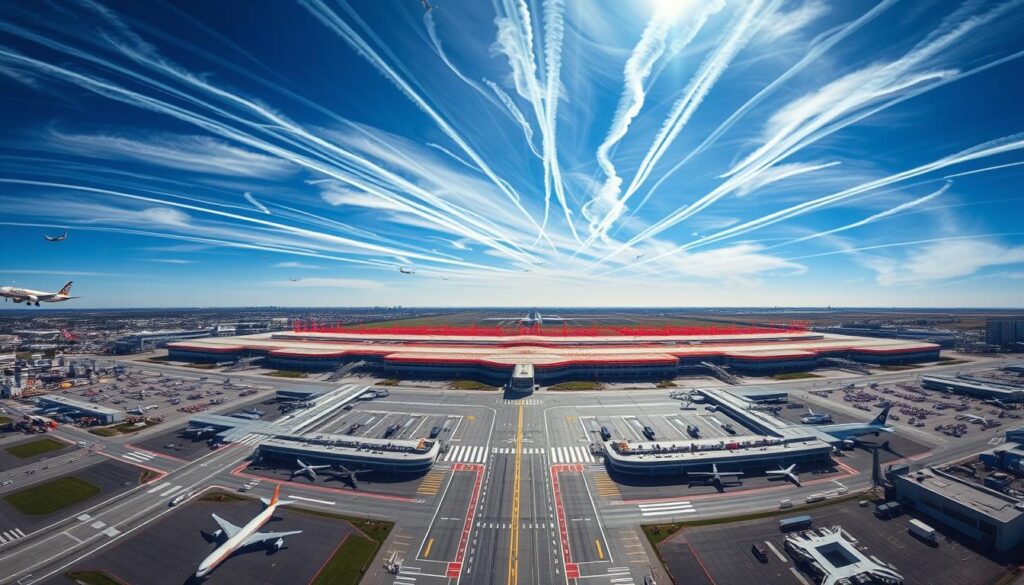Imagine planning your dream trip for months, only to discover new rules could upend everything. That’s the reality many face right now as global relationships shift. Whether you’re visiting family, studying abroad, or closing a business deal overseas, recent changes demand your attention.
At Travelyoudo.com, we understand how overwhelming this feels. That’s why we’ve created this guide to simplify the complex policy updates affecting cross-border movement. You’ll learn about surprising developments like streamlined visa programs for researchers and sudden airline route cancellations across North America.
These aren’t just headlines—they’re real challenges for anyone with international plans. Diplomatic shifts have led to new tariffs, while some carriers quietly reduce transatlantic flights. Even students exploring overseas programs face unexpected hurdles.
Key Takeaways
- EU nations now offer faster visa approvals for academics and professionals
- Major Canadian airlines have eliminated 15% of U.S. routes this quarter
- Updated tariff policies impact luggage fees and ticket pricing
- Tourist visas require additional documentation in some regions
- Real-time policy trackers help avoid last-minute cancellations
We’ll help you navigate this evolving landscape with clear, practical advice. From altered booking strategies to understanding diplomatic nuances, consider this your roadmap through today’s travel uncertainties.
Overview of the Europe-US Travel Freeze
International movement patterns are undergoing dramatic changes. While headlines suggest strict bans, the reality involves nuanced policy adjustments affecting different traveler groups. These shifts create both obstacles and openings depending on your destination and purpose.
Understanding the Current Travel Disruptions
Recent border reports reveal a 12.5% drop in northern entries during February, climbing to 18% by March. Canadian carriers cut 15% of U.S. routes this spring, reflecting shifting demand. Meanwhile, European nations actively recruit American researchers through faster visa approvals.
Key Events and Recent Developments
Three factors define this transformation:
| Category | 2023 | 2024 |
|---|---|---|
| Transatlantic Flights | 1,200 weekly | 980 weekly |
| Visa Processing Time | 45 days | 22 days (academics) |
| Border Crossings | 2.1M monthly | 1.7M monthly |
Diplomatic tensions influence luggage fees and ticket pricing. Students and business travelers now face stricter documentation rules in some regions. Yet specialized professionals discover improved access through targeted programs.
Political and Policy Implications for U.S. Travelers
Policy changes in Washington and Brussels are altering travel dynamics. American professionals now navigate a landscape where domestic decisions impact international mobility. These shifts create both roadblocks and pathways depending on your career field.

Science Funding Shifts Create Ripple Effects
Recent moves to freeze science budgets have surprised many researchers. “When key programs lose support, collaboration opportunities shrink,” explains a Travelyoudo.com analyst. This uncertainty pushes academic professionals to explore options abroad.
Streamlined Pathways Emerge Overseas
European leaders are capitalizing on this moment through visa reforms. Commissioner Iliana Ivanova states:
“We want to create opportunities for those seeking alternatives.”
The changes show in processing times:
| Applicant Type | 2023 Processing | 2024 Processing |
|---|---|---|
| Researchers | 58 days | 19 days |
| Business Travelers | 32 days | 28 days |
| Tourists | 21 days | 34 days |
While leisure trips face more scrutiny, qualified professionals gain advantages. Government efforts to attract talent mean some applications now skip multiple approval layers. These policies reshape traditional travel patterns in unexpected ways.
Industry Responses and Airline Adjustments
Airlines are rewriting their playbooks as passenger priorities shift. Major carriers face tough choices between maintaining familiar routes and chasing emerging opportunities. Strategic adjustments now determine who stays airborne in this transformed market.
Analysis of Shifting Airline Routes
Recent flight schedule changes reveal clear patterns. Air Canada trimmed Montreal-San Francisco trips from 14 to 7 weekly, while WestJet axed its Vancouver-Austin route completely. These cuts reflect broader operational pivots:
| Route | 2023 Frequency | 2024 Frequency |
|---|---|---|
| Vancouver-Miami | 4x weekly | 3x weekly |
| Calgary-New York | 6x weekly | 5x weekly |
| Montreal-San Francisco | 2x daily | 1x daily |
Impacts on Major Carriers
Flight Centre Travel Group Canada reports business bookings dropped 40% this quarter. “Demand patterns forced rapid operational changes,” says their spokesperson. Carriers now prioritize routes with steadier passenger numbers and higher margins.
While some cities lose service, others gain attention. Airlines shift capacity to markets showing stronger demand, creating new connection opportunities. Travelers might find better deals on less crowded routes as carriers compete for redirected traffic.
europe freezes us travel: What It Means for US Travelers
International movement now presents a paradox of possibilities. While Tourism Economics predicts a 15.2% drop in overseas visitors to America this year—with German arrivals down 30%—opportunities are growing for those looking outward. Visa processes reveal this duality: leisure applications face delays, but specialized professionals see faster approvals.

March data shows surprising trends. Spanish entries to the U.S. fell 25%, yet American applications for European academic programs jumped 18%. “This shift reflects changing priorities,” notes a Travelyoudo.com advisor. “Many are trading short vacations for career-building experiences abroad.”
The immigration landscape now favors specific groups. Researchers and tech professionals can secure residency permits 40% faster than last year through EU talent initiatives. Meanwhile, traditional tourist routes face tighter controls and higher costs.
Key strategies emerge for savvy travelers:
- Focus applications on countries offering financial incentives for skilled workers
- Prepare documentation showing professional qualifications or study plans
- Monitor airline routes shifting capacity to educational hubs like Berlin and Lyon
These changes create unique windows for career growth despite broader market disruptions. Understanding which doors are opening—not just closing—helps turn travel challenges into transformative experiences.
Impact on Academic Exchanges and Scientific Research
Global research partnerships are entering a transformative phase. The EU’s Horizon Europe program now offers American scientists access to €95.5 billion spread across seven years—a financial commitment reshaping career decisions. “We’re creating stability for those seeking alternatives,” explains European Research Council President Maria Leptin, positioning the region as a strategic destination.
EU’s Strategy to Attract U.S. Researchers
New visa policies slash approval times for academic applicants. Specialized channels process research-related requests 60% faster than standard applications. This aligns with plans for unified scientific permits across member nations by 2025.
| Initiative | 2023 Status | 2024 Update |
|---|---|---|
| ERC Grants to Americans | 220 | 412 |
| Average Visa Wait | 47 days | 19 days |
| Funding Per Project | €1.8M | €2.3M |
Contrasting Science Funding Landscapes
While U.S. research budgets face uncertainty, European programs expand support. Travelyoudo.com analysts note:
“Researchers now weigh long-term stability against short-term convenience.”
The shift shows in career moves. Over 400 American scientists currently lead EU-funded projects, with thousands more exploring opportunities. Resources like housing assistance and language training sweeten these academic packages.
Trends in International Air Travel and Market Shifts
Have you noticed fewer flight options to familiar destinations lately? The aviation world is undergoing its biggest transformation since pandemic recovery. Carriers are rewriting route maps to match new passenger priorities, creating surprising opportunities for savvy flyers.

Recent months revealed a dramatic pivot in flight operations. Business trips between Canada and America plunged 40% early this year, according to Travelyoudo.com data. Airlines responded by shifting planes to routes showing stronger demand.
Reallocation of Airline Capacity
Major carriers are betting big on transatlantic connections. Air Canada now flies daily to Paris and Rome instead of weekly, while WestJet added three new London-Dublin routes. This capacity reallocation reflects strategic calculations:
| Route | 2024 Frequency | 2025 Frequency |
|---|---|---|
| Toronto-Frankfurt | 5x weekly | 9x weekly |
| Calgary-London | 4x weekly | Daily |
| Montreal-Rome | Seasonal | Year-round |
The market shift brings mixed results for travelers. More European flights mean better deals during off-peak periods. However, reduced North American routes could mean pricier tickets for domestic trips.
Industry experts note this pivot marks a fundamental change. “Carriers aren’t just adjusting schedules—they’re reimagining their networks,” says a Travelyoudo.com analyst. The moves represent billions in redirected investments aiming for stronger returns.
What does this mean for your plans?
- Compare prices on alternative airports for European getaways
- Book US-bound flights further in advance
- Watch for new loyalty program benefits on upgraded routes
Economic and Border Security Considerations
Border policies are reshaping economic landscapes while aiming to protect national interests. Travelyoudo.com analysis reveals a delicate balance: enhanced safety measures might inadvertently strain vital revenue streams. The US Travel Association warns that a 10% decline in Canadian visitors could erase $2.1 billion from the economy—enough to support 140,000 American jobs.
Strict enforcement practices now influence traveler decisions more than ever. Canada’s advisory about extended device inspections at US entry points reflects growing international concerns. “When security protocols deter potential visitors, everyone loses,” notes a Travelyoudo.com economist. Cities like Miami and New York report 18% fewer international bookings compared to last spring.
The ripple effects reach deep into local economies. San Francisco’s hotel occupancy rates dropped 12% this quarter, while Washington’s restaurant revenues fell 9%. Retailers in tourist hubs face tough choices as foot traffic dwindles.
Travelers increasingly seek destinations with predictable entry processes. Countries offering streamlined digital authorization systems now capture 23% more visitors annually. This shift forces policymakers to reconsider how border strategies impact both security objectives and economic realities.
Finding middle ground remains critical. As one industry leader observes:
“We can protect our nation without turning away those who sustain it.”
Government Reactions and Diplomatic Responses
Recent policy shifts are reshaping how nations interact at the highest levels. Leaders worldwide face tough choices balancing economic interests with political priorities. These decisions create ripple effects across borders, affecting everything from trade agreements to personal travel plans.
U.S. Government Actions and Tariff Measures
President Donald Trump’s administration made bold moves this spring. A new executive order slapped 40% tariffs on Brazilian goods, pushing total rates to 50%. This marks one of the most aggressive trade actions in recent history.
Secretary Rubio announced parallel visa restrictions targeting foreign officials involved in censorship. “These measures protect American values,” a Travelyoudo.com analyst notes. “But they also complicate international relations.”
| Policy Action | Impact Area | Effective Date |
|---|---|---|
| Brazil Tariff Increase | Trade Relations | April 2024 |
| Visa Restrictions | Diplomatic Ties | May 2024 |
| Official Visa Revocations | Judicial Relations | Ongoing |
International Diplomatic Perspectives
Global leaders express growing concern over these developments. Multiple countries now review their policies toward American visitors. Brazil responded by tightening visa rules for U.S. citizens last week.
President Donald Trump’s approach reflects an “America First” strategy. While popular domestically, it risks straining partnerships abroad. Travelyoudo.com reports increased demand for real-time policy alerts as tensions escalate.
“Diplomatic decisions now directly impact family visits and business trips alike.”
Travelers should monitor official announcements closely. Even minor policy changes could affect entry requirements or flight availability.
Conclusion
Global mobility is entering a new era of strategic navigation. The structural shifts reshaping international movement demand fresh approaches to trip planning and career development. Airlines demonstrate remarkable agility, redirecting capacity to emerging markets while maintaining safety standards.
At Travelyoudo.com, we see dual narratives unfolding. While leisure trips face tighter controls, specialized professionals find accelerated immigration pathways. Academic exchanges and tech-focused roles now dominate cross-border trends, with visa approvals for researchers dropping below three weeks in some regions.
Our team recommends three strategies:
- Align travel plans with countries offering talent incentives
- Monitor airline operations shifting toward education hubs
- Utilize digital tools tracking real-time policy updates
These changes aren’t temporary adjustments—they’re foundational transformations. By staying informed through trusted resources and embracing flexibility, travelers can turn current challenges into career-defining moves. We’re here to help you navigate this evolving landscape every step of the way.
FAQ
How does the travel freeze affect flight availability between the U.S. and Europe?
Airlines like United and Delta have reduced routes to major hubs such as Frankfurt and Amsterdam. San Francisco International Airport reports fewer transatlantic flights, with capacity shifting to Asian or domestic markets. Always check with carriers for real-time updates.
Are visa policies changing for U.S. travelers visiting Europe?
The EU is streamlining visa processes but tightening enforcement for long-term stays. New digital systems may delay applications. Double-check requirements through official channels like the European Travel Information and Authorization System (ETIAS) before booking.
What adjustments are airlines making to adapt to these shifts?
Carriers are reallocating aircraft to high-demand regions like Asia and South America. For example, American Airlines cut Paris routes but added flights to Tokyo. San Francisco International Airport now sees more focus on Pacific-bound services.
How will academic collaborations between the U.S. and Europe be impacted?
EU programs like Horizon Europe are actively recruiting U.S. researchers with faster visa approvals and grants. Meanwhile, U.S. science funding faces delays, pushing some institutions to prioritize EU partnerships.
What economic risks does this freeze pose for businesses?
A> Reduced travel could strain tourism-reliant economies and delay cross-border projects. Companies are pivoting to virtual meetings, though sectors like aerospace and hospitality face revenue cuts. Border security upgrades may also increase operational costs.
Has the U.S. government responded to these travel restrictions?
The Biden administration is negotiating with EU leaders to ease caps while prioritizing visa renewals for students and professionals. Tariff threats on European goods remain a leverage point in ongoing talks.
Should travelers reconsider upcoming trips to Europe?
Monitor airline policies and entry rules closely. Consider travel insurance for cancellations. Routes through hubs like Istanbul or Dubai may offer alternatives if direct flights are unavailable.




